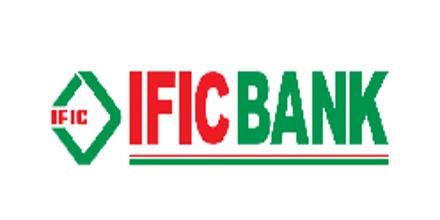Job Experience in Credit Risk Management at IFIC Bank
International Finance Investment and Commerce (IFIC) Bank Limited started banking operations on June 24, 1983. Prior to that it was set up in 1976 as a joint venture finance company at the instance of the Government of the People‟s Republic of Bangladesh. Government then held 49 percent shares while the sponsors and general public held the rest.
The objectives of the finance company were to establish joint venture Banks Finance Companies and affiliates abroad and to carry out normal functions of a finance company at home. When the Government decided to open up banking in the private sector in 1983, the above finance company was converted into a full-fledged commercial Bank. Along with this, the Government also allowed four other commercial Banks in the private sector. Subsequently, the Government denationalized two Banks, which were then fully Government-owned.
Vision:
To be the best Private Commercial Bank in Bangladesh in terms of efficiency, capital adequacy, asset quality, sound management and profitability having strong liquidity.
Mission:
- To build IFIC Bank limited into an efficient, market driven, customer focused institution with good corporate governance structure.
- Continuous improvement in business policies, procedure and efficiency through integration of technology at all levels.
Management Structure
The nine members of the Board of Directors are responsible for the strategic planning and overall policy guidelines of the Bank. Further, there is an Executive Committee of the Board to dispose of urgent business proposals. Besides, there is an Audit Committee in the Board to oversee compliance of major regulatory and operational issues.
The CEO and Managing Director, Deputy Managing Directors and Head of Divisions are responsible for achieving business goals and overseeing the day to day operation. The CEO and Managing Director is assisted by a Senior Management Group consisting of Deputy Managing Directors and Head of Divisions who supervise operation of various Divisions centrally and co-ordinates operation of branches. Key issues are managed by a Management Committee headed by the CEO and Managing Director. This facilitates rapid decisions.
There is an Asset Liability Committee comprising member of the Senior Executives headed by CEO and Managing Director to look into all operational functions and Risk Management of the Bank.
Remittance Arrangement
There are several exchange houses. Those are as follows;
- IFIC Money Transfer (UK) Ltd
- Oman International Exchange LLC, Oman
- Placid N. K. Corporation, USA (Global)
- Multinet Trust Exchange LLC, UAE
- Al-Fardan Exchange, UAE
- Coinstar Money Transfer Ltd., UK (Global) etc
My Job Description
General Banking department:
I started my internship in Kawran Bazar branch Of IFIC Bank LTD. at General banking department.
General Banking department generally deals with five sections e.g. Cash, Bills and clearings, remittance, accounts, account opening. However, my work was limited to Account opening section, Bills and clearing section and Local Remittance section. I had been given access to unique software, called MISYS. I had to be logged in with username and password, and then search for specific clients.
Credit Division:
During my internship, I spend around one month in credit division. During this period, my specific responsibilities were as follows:
Creating Spreadsheet and updating previous spreadsheet:
In case for a new client, whose financial records has not previously been entered into the system, I had to prepare new spread sheet for specific clients based on the company financials data provided.
Entering reported figures:
Sometime I assisted the officers concerned in the department to verify their old reports as well as completed those by entering the PIN code, passport and National ID of their clients. I prepared some spread sheet of their loan classification, SOD account information and etc.
Factory visit report:
Factory visit is part of the process in evaluating client‟s operational activities and granting credit approval. A general template is used to record information while visiting to a client‟s factory. I have worked on such template to record information based on the notes taken by an associate of local corporate, while gathering additional information from the client‟s company websites.
Other activities
- writing business letters to clients
- checking of draft copy of mortgage deed
- checking of charge documents in accordance with sanction terms
- preparation and checking of CIB ( Credit Information Bureau )
- checking of Customers applications
- Entry of Loan Documents in documentations registers
- Checking of credit rating grading system (CRG)
- Conducting Financial analysis of a loan proposals (NPV ,IRR etc)
Credit Risk Management: A Theoretical Framework
In general, a banking system aggregates a high number of low value deposits to fund enterprises with a smaller number of high value loans. This intermediation through a wellfunctioning bank helps to achieve some economic benefits for the depositors, the borrowers and above all the economy in the following ways:
The Depositors
- Higher return
- Lower risk
- Greater liquidity
The Borrowers
- Availability of fund for all credit worthy Borrowers.
- Thus allow to enterprises grow and expand.
The Economy
- Economic growth is maximized as the Bank channels the country‟s scarce financial resources into those opportunities with maximum return
- Thus, profitable enterprises receive funding, grow, and expand
- Loss making enterprises are refused funding and allowed to go out of the business thus saving the economy from drainage of resources.
The Bank must allocate loans effectively for achieving these broad objectives of the Economy and the prerequisites are:
- Banks are able to identify reliably those enterprises that can repay their loans.
- Banks allows loan to those enterprises likely to yield high return and deny loan to those likely to yield low or negative returns. While identifying profitable enterprises, the Bank in fact identifies risks of the borrower and business in order to allow loan in the context of its risk return profile. In other words, Banks are in the business of risk taking; as such risk management is viewed as a core function of banking.
Credit Risk:
(a) Credit risk arises from the bank‟s dealing with or lending to Corporate / Individual and Financial institutions. For most banks, loans are the largest and most obvious source of credit risk; though, credit risk may arise from both on and off balance sheet activities. Besides accounting loss, credit risk is to be viewed in the context of economic exposure of the Bank which encompasses opportunity cost, transaction cost and expenses associated with non performing loans. .
(b) In a Bank‟s portfolio, losses stem from the outright default due to inability or unwillingness of a customer or a counter party to meet commitments in relation to lending, trading, settlement and other financial transactions.
(c) Thus the objectives of credit risk management are as follows;
- Identifying, measuring, monitoring and controlling credit risks in order maintaining a manageable and quality loan portfolio.
- Ensuring that expected returns compensate for the risks taken.
iii. Ensuring credit risk decisions are explicit, clear and well calculated.
- Maintaining the overall credit exposure of the Bank at prudent levels consistent with the available capital
- Ensuring top management as well as individual responsible for credit risk management has sound expertise and knowledge to take credit risk and accomplish risk management functions.
(d) Credit Risk Management (CRM) is a dynamic process which enables banks to proactively manage loan portfolios. Four major areas of CRM are:
- Policy — Lending guidelines
- Procedure — Evaluating viability and associate risks of business enterprises.
- Organizational structure — segregation of risk taking and risk approving authority
- Responsibility — Decision making and accountability
A clear understanding of the four areas are crucial for maximizing Bank‟s earning by carefully evaluating credit risks and attempting to minimize those risks.
As a financial enterprise, IFIC Bank is also in business and maximizing stake holders‟ value (share holders, depositors, borrowers, employees and the public) is Bank‟s prime objective. The loan portfolio of the Bank is primary source of earnings. It generates most of the interest income, and it also consumes most of resources i.e. deposits. But it may also be Bank‟s great concern for survival and sustainable growth in an ever changing environment.
Credit Risk Management Policy will be reviewed annually to accommodate necessary changes in respect of risk mitigation. Thus Bank‟s endeavor shall be to maintain a manageable loan portfolio which is rewarding by taking calculated risk and ensuring quality of loans.
OBJECTIVES OF CRM (Credit Risk Management)
(i) Maximize Bank‟s earning from loan portfolio.
(ii) Improve quality of loan portfolio to maximize earnings by:
- To keep non-performing assets below 5%
- Arresting new loans to become classified
(iii) Utmost emphasis on loan sanctioning is to be given in order to improve quality of the loan portfolio. Credit facilities are to be considered solely on viability of business/enterprises / project / undertaking having adequate cash flows to adjust the loans, and management capacity of the borrower to run the business profitably.
(iv) Evaluate credit risks before sanctioning, which may hamper generation of the projected cash flows of the borrower and might delay or hinder repayment of Bank‟s loan.
(v) Monitor continuously performances of the financed projects/ business / enterprises will be Bank‟s main thrust for ensuring repayment of the loan, and receiving early warning (EL) for taking timely corrective measures.
(vi) Price the loans on the basis of loan pricing module of the Bank focusing on risk rating of the borrower.
(vii) Strict adherence to Bangladesh Bank‟s policy guidelines.
Credit Risk Management Process:
Credit risk management process covers the entire credit cycle starting from the origination of the credit in a financial institution‟s books to the point the credit is extinguished from the books (Morton Glantz, 2002). It is provided for sound practices in:
- Credit Processing or appraisal
- Credit approval or sanction
- Credit documentation
- Credit administration
- Disbursement
- Monitoring and control of individual credits
- Monitoring the overall credit portfolio (stress testing )
- Credit classification and
- Managing problem credits /recovery
Qualitative Judgment:
Whether any continuous credit or Demand Loan or Fixed term loan are classifiable or not on the basis of objective criterion but there is doubt or uncertainty for recovery of that loan then the loan will be classified on the basis of Qualitative Judgment (QJ).
If the recovery of the credit becomes uncertain resulting from change of circumstances under which credit was extended or the borrower sustains loss of capital or the value of the security decreases or there may be any adverse situation then the credit will be classified on the basis of Qualitative Judgment. Besides, if the credit is extended without any logical grounds or the credit is rescheduled frequently or the rules of rescheduling are violated or the trends of excess over limit (EOL) is observed frequently or a suit is filed for recovery of the credit or the credit is extended without the approval of the competent authority, then the loan will be classified on the basis of Qualitative Judgment.
Due to the reasons stated above or for any other reason despite possible loss of any credit, there is probability of changing the present situation resorting to proper steps, the credit will be classified as Sub-Standard on the basis of Qualitative Judgment. But even after taking proper steps, if the full recovery is not ensured, the credit will be classified as Doubtful and after rendering all out efforts, if the probability of recovery becomes totally bleak the credits will be classified as Bad Loan.
The Bank will classify the credit on the basis of Qualitative Judgment and if any improvement is achieved, those credits will again be declassified.
Once a credit is classified by Bangladesh Bank (Inspection Team) the credit will remain classified unless its status is changed upon required repayment/reschedulement. The account once classified by the Bank Inspection Team may be declassified with approval from the Board.
While submitting such proposal before the Board the Relationship Manager/ Manager of the concerned Branch vis-a-vis the Managing Director shall give a certification stating that all norms required for declassification of such account has been duly observed. Declassification is to be informed to Bangladesh Bank within 15(fifteen) days from the date of declassification approved by the Board. Bangladesh Bank shall take punitive measure if norms are not followed.
Assignment of Accounts (Account Transfer Procedures) to RAM Division:
Within 7(seven) days of a account being downgraded as Sub-Standard, a Request for Action and a Handover/ Downgrade Check List shall be completed by the RM and forwarded to Corporate Banking & Marketing (CBM) Division, Head Office, Dhaka. The CBM handover the respective account to Remedial Asset Management (RAM) Division through CRM with their comments and views. Simultaneously, RM will review all documentation, meet the Customer and prepare a Classified Loan Review (CLR) within 15(fifteen) days after the completion of Handover/ Downgrade Check List and forward it to RAM for its approval.
Remedial Asset Management shall ensure that the following steps are carried out when an account is classified as Sub-Standard or worse:
- Facilities are withdrawn or repayment is demanded as appropriate. Any drawings or advances shall be restricted and disbursement/drawing can only be approved after careful scrutiny and approval from appropriate executives within CRM.
- CIB reporting is updated according to Bangladesh Bank guidelines and the borrower‟s Risk Grade is changed as appropriate.
- Loan loss provisions are taken based on Forced Sale Value (FSV).
- Loans are only rescheduled as per Loan Rescheduling guidelines of Bangladesh Bank. Any rescheduling shall be based on projected future cash flows specifically determined.
- Prompt legal action shall be taken if the borrower does not cooperate.
PERSUASION AND FOLLOW UP
Recovery persuasion shall start depending upon the nature and merit of advance. In cases of continuous and demand loan, persuasion shall start as soon as operation of the account becomes unsatisfactory, irregular and its validity expires. But in case of Term Loans, persuasion has to be made when the borrowers refrain from paying installments. Nevertheless, persuasion may start any time ahead of these criteria if Bank perceives that a loan account has lost its merit somehow and seems to be difficult for recovery in future.
Persuasion at initial stage of default:
Borrowers become unwilling to repay for various reasons. Some of the borrowers incur loss in their businesses resulting disruption of cash inflow to such a high degree that they cannot repay Bank‟s loans. Some borrowers divert their fund to businesses/enterprises other than the business for which the Bank loan was sanctioned which is undesirable. Furthermore, there are willful defaulting borrowers as well.
Depending on the nature of the borrower involved, the style and degree of persuasion shall differ from case to case keeping in mind that the ultimate aim is to recover and settle defaulting loan within the shortest possible time with a view to ensuring maximum return for Bank.
Various modes of persuasion are as under:
Letters/reminders:
In case of continuous loans like Cash Credit (Hypo), Cash Credit (Pledge), Secured Overdraft etc. letters/ reminders are to be sent two months ahead of expiry date of limit to get response of the borrower whether they are interested for renewal of the limit. In case of unsatisfactory performance of the account, a letter shall be issued to the concerned borrower allowing 30(thirty) days time to repay Bank‟s dues with interest. In case of Term Loan Accounts, such letters shall be sent to the borrowers as soon as one installment remains unpaid urging them to regularize their account. Copy of such letters shall be endorsed to the Guarantors/mortgagors if any. Reminders are required to be sent on fortnightly/monthly intervals. Constant follow up through letters shall be made to the borrowers availing Demand Loan, LIM, LTR and for PAD outstanding to regularize their account and to avoid classification.
Inspections/Site-visits:
Concerned Branch / RM shall collect information regarding reasons of default through personal contact / visit etc. Branch Officials shall inspect the shop/godown/factory/residential address of the borrower to ascertain the position of their business and reason of failure. They will submit report along with their findings. On the basis of their report and information provided by the borrower Branch/RM shall ascertain the reasons of default. Branch/RM shall also assess the valuation of securities held against the advance, if such information is not updated.
FINDINGS AND RECOMMENDATIONS:
Findings and Analysis based on Total Credit Management System Of IFIC Bank:
- Online banking system is available in IFIC Bank though it is not improved that is very important to compete to others in the electronic world.
- For credit appraisal, the bank takes some time depends on the client for its authentication.
- All the employees are not professionally trained enough in the computer literacy part.
- Most of the borrower does not pay their payment timely.
- Although all the existing manpower is utilizing their utmost efforts productivity sees not adequate due to lack of utilization of latest technology.
- Heavily dependent on head office decisions delayed the prompt disposal of decisions or service delivery.
- It is observed that the fraud forgery is comparatively very low may also be lower if the employees are poorly motivated towards bank‟s motive.
Recommendation Based on overall Credit Management System:
- Need to improve its Online Banking system so that it can compete with other banks.
- Respective personnel‟s should be trained to overcome the deficiency in regards to increase its productivity of employees.
- There should be reliable efficient personnel in every branch in order to take independent decisions and make prompt service delivery.
- Strict Supervision must be adapted in case of high risk borrowers. Time to time visit to the projects should be done by the bank officers.
- The performance evaluation system is not updated. The organization should follow the 360-degree performance evaluation system. In this case, the superior executives will not be much rude to the subordinates because the top-level employees‟ performance will be evaluated by the subordinates
Conclusion:
Banking sector of Bangladesh consists of several nationalized and private banks. They are doing their activities and highly contribute to the national economy. Among them IFIC Bank Limited also makes significant contribution to the economy. They are performing their activities, as a result not only the bank but also the economy is benefited. The bank is performing general banking, Loan-advance, foreign exchange activities etc, as a result they are mobilizing the money and do well for the economy. Although they have some limitations in their services, they are doing tremendous job for the economy. If they can reduce their limitation and introduce new ideas, they can do better in the banking sector of Bangladesh.
















